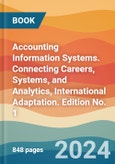Accounting Information Systems presents a modern, professional perspective that develops the necessary skills students need to be the accountants of the future. Through high-quality assessment and a tool-agnostic approach, students learn course concepts more efficiently and understand how course concepts are applied in the workplace through real-world application. To help students to be the accountants of the future, the authors incorporate their own industry experience and help showcase how AIS concepts are used through tools, spotlighting real accounting professionals and job opportunities.
This international edition provides new and expanded coverage of topics, including components of AIS, database forms and reports, and software tools for graphical documentation. The edition also includes new cases from across the world in the “In the Real World” feature in select chapters, showing how the concepts in the chapter apply to a real-world company or business. Every chapter now includes new Concept Review questions at the end of each section, focusing on key points students need to remember.
Table of Contents
Part I: Foundations of AIS
1 Accounting as Information
1.1 Why Is Accounting Information Important?
1.2 How Have Accounting Information Systems Evolved?
1.3 How Does Management Use Information?
1.4 What Is the Relationship Between Accounting and Data Analytics?
2 Risks and Risk Assessments
2.1 How Do We Understand Risk?
2.2 What Are the Types of Risks?
2.3 How Do We Prioritize Risk?
2.4 How Do We Respond to Risk?
3 Risk Management and Internal Controls
3.1 How Do Internal Controls Mitigate Risk?
3.2 How Are Controls Classified?
3.3 How Do We Assess Internal Controls?
3.4 Why Are Internal Control Frameworks Important?
4 Software and Systems
4.1 How Do Systems Capture and Process Data?
4.2 How Do Startups and Small Businesses Use Technology?
4.3 What Are the Characteristics of Information Systems for Growing Companies?
4.4 Why Are Enterprise Resource Planning (ERP) Systems Considered Ideal?
5 Data Storage and Analysis
5.1 What Is Data?
5.2 How Is Data Stored?
5.3 What Makes Data "Big Data"?
5.4 How Do Accounting Professionals Use Data?
6 Designing Systems and Databases
6.1 How Are Systems Developed?
6.2 Which Methodology Should Be Used?
6.3 What Type of Database Should Be Used?
6.4 How Are Relational Databases Designed?
6.5 How Do We Interact with Data in a Database?
6.6 How Can We Create Database Forms and Reports?
7 Emerging and Disruptive Technologies
7.1 How Do Companies Approach Emerging and Disruptive Technologies?
7.2 How Do Disruptive Technologies Provide Business Opportunities?
7.3 How Does Robotic Process Automation (RPA) Benefit Accounting Professionals?
7.4 What Is Blockchain?
7.5 Why Should Accountants Care About Blockchain?
8 Documenting Systems and Processes
8.1 Why Do We Document Systems and Processes?
8.2 How Do We Know Which Type of Documentation to Use?
8.3 How Do Flowcharts Illustrate Systems or Business Processes?
8.4 How Do Data Flow Diagrams Show Information Flow?
8.5 What Software Tools Can Be Used for Graphical Documentation?
Part II: Business Processes
9 Human Resources and Payroll Processes
9.1 How Are Human Resources and Payroll Related?
9.2 How Are New Employees Hired?
9.3 What Happens When an Employee Is Terminated?
9.4 How Do We Compensate Employees for Their Work?
9.5 How Can Human Resources and Payroll Data Be Used to Identify Risks?
10 Purchasing and Payments Processes
10.1 What Is the Relationship Between Purchasing, Inventory Management, and Supply Chain Management?
10.2 How Are Inventory and Other Goods and Services Purchased?
10.3 What Makes Fixed Assets Unique to Purchasing and Payments?
10.4 How Do We Evaluate the Credit Payments Process?
10.5 How Does the AIS Capture Purchasing and Payments Data?
11 Conversion Processes
11.1 What Is the Relationship Between Conversion Processes, Inventory, and Supply Chain Management?
11.2 Why Is Cost Accounting Important to the Accounting Information System?
11.3 What Is Digital Manufacturing?
11.4 How Is Data Collected and Used?
12 Marketing, Sales, and Collections Processes
12.1 How Do Marketing, Sales, and Collections Complete the Business Model?
12.2 Why Are Business Credit Sales More Complex Than Consumer Cash Sales?
12.3 How Do We Ensure That Revenue Is Correctly Recognized?
12.4 How Are Customer Payments Collected?
12.5 Which Reports and Analytics Give Insights into These Processes?
13 Financial Reporting Processes
13.1 How Is an AIS Involved in Financial Reporting?
13.2 How Are Financial Statements Generated by an AIS?
13.3 How Does XBRL Create Efficient Financial Reporting?
13.4 Are There Other Important Financial Accounting Reports?
13.5 How Is Financial Reporting Data Used for Insights and Decision Making?
Appendix A: Expanding the Accounting Equation: From Balance Sheet to Statement of Cash Flows
Part III: Risk Assurance
14 Information Systems and Controls
14.1 What Framework Can We Use to Mitigate Risk Around Our Systems?
14.2 How Do We Decide Who Can Access Systems?
14.3 How Do We Physically Protect Our Systems?
14.4 How Do We Keep Our Systems Running?
14.5 How Do We Make Changes to Systems?
15 Fraud
15.1 What Is Fraud?
15.2 How Do We Manage Fraud Risk?
15.3 How Does Asset Misappropriation Result in Fraud?
15.4 What Are the Characteristics of Financial Statement Fraud?
16 Cybersecurity
16.1 How Is Cybersecurity Relevant to the Accounting Profession?
16.2 How Do Cybercriminals Plan Attacks?
16.3 How Do Hackers Gain Unauthorized Access?
16.4 How Do Attackers Shut Down a System?
Part IV: Technology and Analytics
17 Data Analytics
17.1 How Is Data Analytics Changing the Accounting Profession?
17.2 How Do We Explore a Data Set?
17.3 How Do We Investigate Interesting Occurrences in a Data Set?
17.4 Which Analytics Techniques Are Gaining Popularity in the Accounting Profession?
18 Data Visualization
18.1 How Does Visualization Tell a Story with Data?
18.2 What Are the Fundamentals of Design?
18.3 How Do Visualizations Help Us Explore Data?
18.4 When Should Explanatory Visualizations Be Used for Storytelling?
19 Audit Assurance (online chapter)
19.1 What Is the Difference Between Internal Audit and External Audit?
19.2 How Are Internal Audits Performed?
19.3 How Is Testing Performed?
19.4 What Happens After an Audit?








